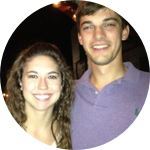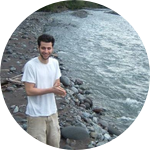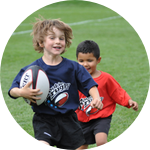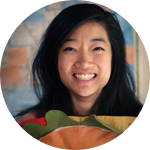Abstract
When a healthy person suffers from a cut or a burn, immune system cells rush to the damaged area to repair. One of the most important of these defenders is the neutrophil — a type of white blood cell that moves quickly to gobble up bacteria that can cause infection. One of the greatest challenges in helping patients recover from infection is that we still don’t understand how our own immune cells do this effectively, why these immune cells sometimes fail, and how to improve the immune response. So last year, my colleagues and I had a novel idea: what if we created a contest, a cellular race, where top scientists from the US and Europe competed to design a new, super-cell that could be faster and smarter than all cells used in the lab? Our results showed that not only could we engineer a better cell, but that this contest approach helped spread new techniques and knowledge. The winners from the first ever Dicty cell race demonstrated new techniques that could improve developments in treating burn victims, infectious disease, and cancer.
Introduction
Neutrophils are the most abundant type of of white cells in the blood. A healthy person has about 20 billion neutrophils in his blood. The neutrophils are the first cells to respond when an infection happens, by moving from the blood into the infected tissue. After a minor scratch, the first neutrophils arrive within minutes at the injured tissue, moving along the shortest path.
Typically, neutrophils are successful at protecting the body from foreign invaders. They’re ‘fast’ and ‘smart’, meaning they can sense harmful bacteria through chemical cues and can move towards the target quickly without getting tripped up by obstacles in our tissues, like other cells or collagen fibers. 90% of the time, scientists have found, they choose the shortest route to their target.
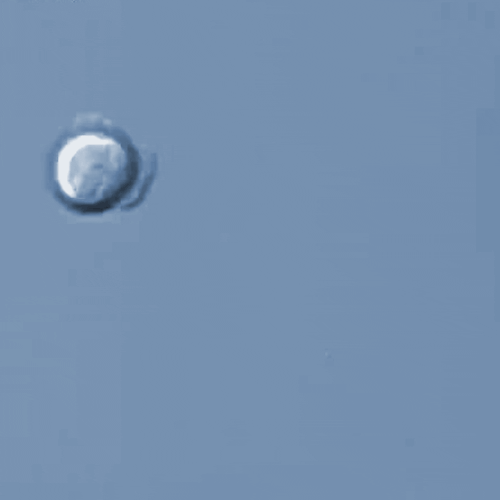
The cells of our focus are Dicty and HL60, because they closely resemeble the neutrophils found in the human immune system and are very commonly studied. Dictyostelium discoideum, aka Dicty, is a single-cellular amoeba. HL60 is a strain of cells that come from a human leukemia cell line. Studying these cells in the lab helps us understand chemotaxis, which is how cells move across long distances.
But in burn patients, for example, neutrophil migration and chemotaxis is often impaired following a major injury. If you take a microscope, and put a slide of neutrophils from a healthy person next to that of a burn victim, the neutrophils from the injured person look lost or misguided. They tend to move randomly and chaotically. And when they miss the target or get there too slowly, they put patients at a high risk of infection and sepsis.
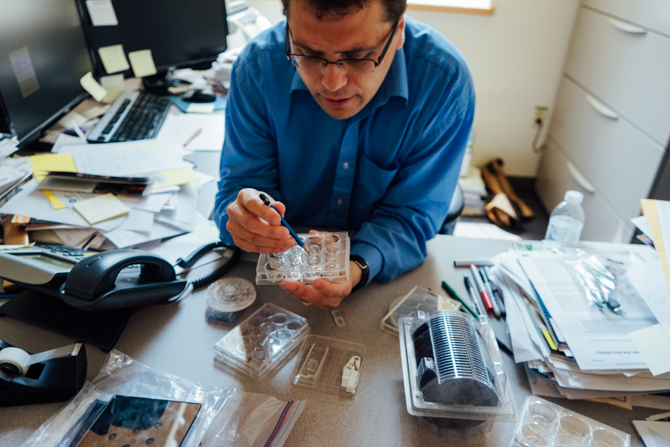

So how do healthy neutrophils know how to get it right? This is the question that we care about. If scientists can figure out how these important immune system players make decisions, we can engineer them to be faster and smarter and fix them when they fail. It’s the first step for developing more effective therapies for patients suffering from burn injuries, antibiotic resistant infections, sepsis AIDS, or even cancer.
We invited scientists from top labs all over the world to engineer a new ‘neutrophil’ to be entered into a cell race. Using the funds raised from Experiment, we set a grand prize of $5,000. The team that created the fastest and smartest cell, measured by its ability to find and reach the ‘target’, would take home the winning spoils.
Methods
To understand neutrophils better, in the lab we use two model systems: Dictyostelium and HL60. Dictyostelium discoideum, aka Dicty are single-cellular, social amoebas that are smart, but slow. HL60 cells come from a human leukemia cell line, and are fast, but dumb. The major reasons biologists like these models, instead of human neutrophils, is that they are easier to work with and can be genetically manipulated.
We use both together to get a closer approximation of how a neutrophil would respond to similar manipulations. A model system that is both slow and dumb would be ideal, but there isn’t a cell line for that, maybe because no one is looking at these exact “traits”.
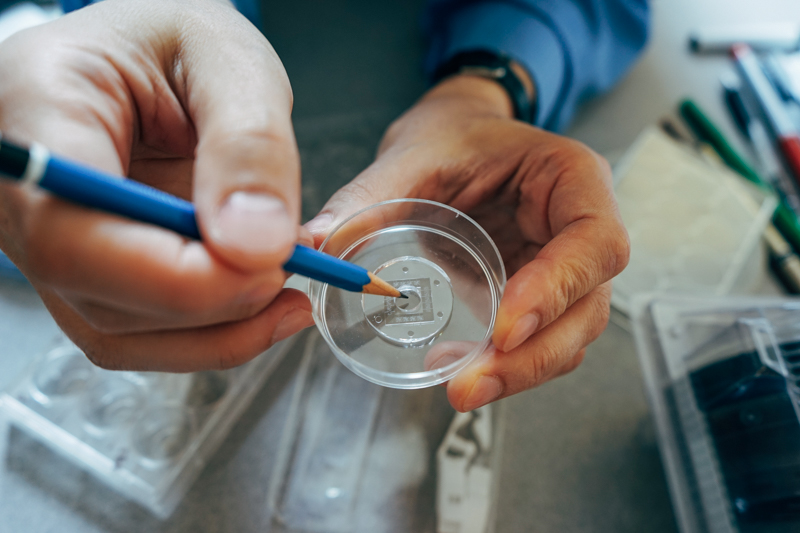
By tinkering with the genetics of the Dicty or HL60 cells, the 15 scientists that signed up for the race optimized their entries with their best guess for speed and decision making. Some sent in cells that had stronger muscles, others sent in cells that had better adhesion, and others sent us precocius cells that would mature faster than their peers. Some were interested in making the cells super-sensitive to stimuli, by amplifying certain signaling pathways. Some teams sent in wild-type cells pre-mixed with a chemical cocktail.
The ‘race’ was held inside the world’s tiniest race course — a maze of pin-tip-wide channels that bifurcate into long paths, short paths, and dead-ends. At the finish-line is a trough of chemoattractant, which simulates the neutrophils’ target and diffuses through the maze.
Cells navigate through the maze by following the chemical gradient created by diffusion of the attractant from the reservoir at the finish. An analogy would be to placing freshly cooked bacon at the end of a maze and having a dog navigate its way to the finish by following the delicious bacon smell.

Before the race, we shared the rules and details at the Dicty World Race website. The maze was designed that cells would enter from the bottom and move towards the top chamber (bright green). Shown in the first image below is a gradient from a small flourescent molecule, two hours after the start of the experiment (no cells in this experiment). The channels are just 5 micrometers thin and the pitch of the grid is 50 microns. The total distance cells will have to travel is about 800 microns, about as thick as a typical paperclip. It would take more than one hour for a cell to move all the way through the maze, that is if they managed to avoid the dead ends.
In order to participate in the race, labs had to qualify by choosing their favorite cells and testing them in dishes that we mailed to participants beforehand. 35mm dishes, 6-plate wells, and 10 plates total were sent to each lab that signed up.

The day of the race did not go entirely according to plan. We had more fun and our lab got more crowded during the race than we ever expected! We did encounter difficulties despite our planning. Some are worth mentioning, so that next year we can strive to improve on these shortcomings.
We received 15 cell lines, 12 Dicty and 3 HL60. Six cell lines showed robust migration through the mazes and reached the end (teams 7, 11, 12, 15, 17, 4). Three lines (teams 1, 9, 18) were slow to start moving (more than 1 hour before entering the race) and by the end of 5 hours, only a few cells crossed the finish line. In the case of cell lines from teams 10 and 20, cells were alive and entered the devices but they did not migrate towards the mazes.
There was a case of mold contamination, from which cells may not have fully recovered in time. Think of athletes getting the flu right before the big day. This problem likely affected teams 1 and 18.
Some Dicty cells did not grow fast enough and did not reach large enough numbers before the race, which might have delayed their proper development. This problem likely affected teams 9 and 20. This is a known issue for Dicty, and having cells that were precocious in their development was a strategy that helped team 15 raise to the fourth place.
Some cells did not take the trip in an ice box across Atlantic very well and could not be resuscitated on arrival. A new batch of cells shipped overnight by team 19 and arrived to our lab just two hours before the race. Now that was some serious jet lag to overcome! Many cells moved but their decision making was impaired.
Lastly, reduced adhesion of cells in the devices likely affected the performance of HL60 strain 5. Think about how tricky the choice of tires can be when a race takes place on a rainy day.
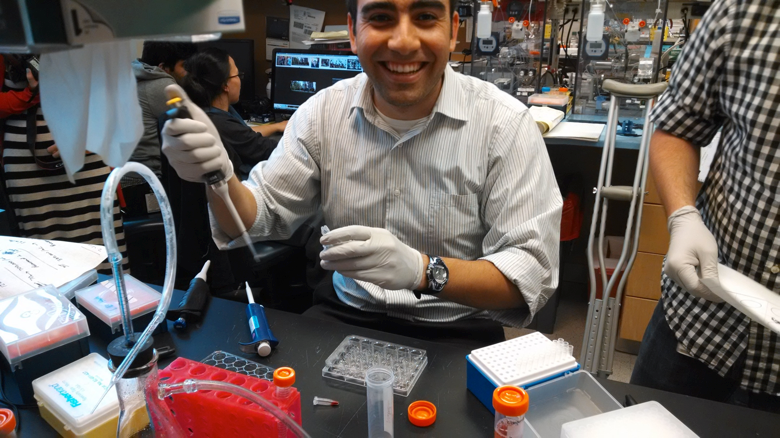
To capture the results, we took still images of each race over the several hours required to complete it. For each team, we were able to compile all of the images into a short movie.
Results
So which team got it right? Well, everyone. Almost all the cells that we received were faster than the wild type. So all the scientists that participated were right —their work did improve some mobility. But, of course, some cells were faster or smarter than others.
The winner was a Dicty cell from the lab of Arjan Kortholt and Peter van Haastert at the University of Groningen in the Netherlands. It was slightly faster, and equally as smart as a wild type. The team had altered the cell’s receptors to be much more sensitive, so that the cell had a more acute sense of smell for the chemoattractant.
Here you can watch the winning cells navigate through the maze.
The winning cells accounted for a remarkable 60% of the cells in the top 100 to finish the race. Taking second place was an Hl60 cell from the lab of G. Charras at University College in London. Charras’ cell had a stronger type of myosin (a protein involved in muscle function). It slowed down the cells, but it made them better at navigating the maze.
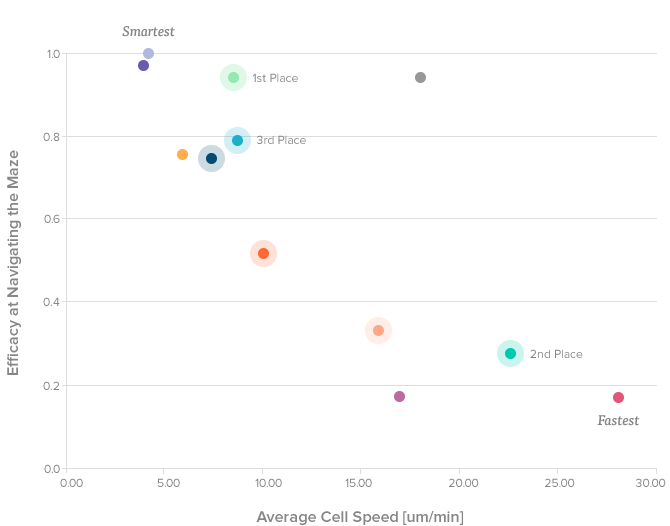
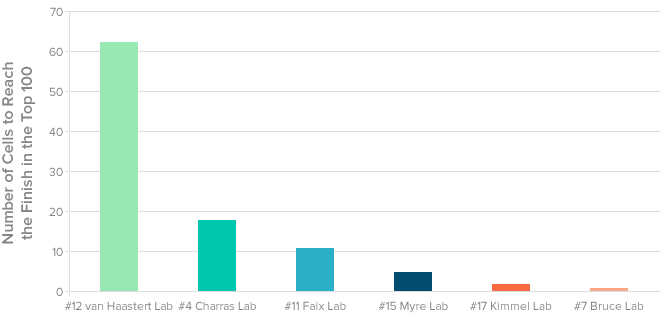
The winning cells of this year’s race are akin to search dogs with enhanced smelling power. These cells over-expressed a protein, Ric8, that amplifies the directional sensing response, making these cells more sensitive to the chemical gradient.
Interestingly enough, the winning cells were not the fastest, but ranked high in efficiency in crossing the maze. In contrast, the second place Charras team was the fastest (qualified) team, but not the most efficient (i.e. they made a lot of mistakes in the maze).
In an unexpected turn of events, the fastest cells were actually a second (and hence unqualified for the grand prize) submission by the team of A. Kimmel. They were clocked going on average 28um/min, which is almost three time as fast as the average Dicty. These cells were wild type cells doped with a special protein mix. Following the rules of the race, the Kimmel team had to choose one submission for the grand prize, which placed an honorable 5th place. If chosen, the "doped" cells would have won the second place, quite a remarkable achievement.
The rest of the team runs can be watched at the Dicty World Race Results page.
2nd Place
Team #4 Guillaume Charras
University College London, UK
3rd Place
Team #4 Jan Faix
Hanover Medical School, Germany
4th Place
Team #15 Michael Myre, Robert Huber
Harvard Medical School, US
Conclusion
We are on track to learn some very exciting science from the Race. We have seen that some modifications of the cellular “machinery” work better than others and surprisingly, that Dicty cells can be “doped” into moving as fast as HL60s, though at the expense of navigation.
From a scientific standpoint, we have much to learn from some of the innovative strategies teams have taken with their cells. These include modifying the mechanical properties of cells to better squeeze through the narrow channels, using wilder strains of Dicty that have been less coddled (and mutated) in the laboratory, and inhibiting the random motion of cells that may interfere with their directed migration.
It will be fascinating to see how these cells perform under optimal conditions. Therefore, we are continuing to work with these teams to perform these experiments and more rigorously evaluate their clever strategies. The fun of the race was just the beginning – the real gold lies in our upcoming publication.
We have a prize, but people didn’t sign up just for the prize. This was an exercise in open science and collaboration. The biggest benefit of our crowdfunded-contest format is that it is an opportunity to educate other scientists on new lab technologies. Our team developed the very precise measurement technology that the ‘race’ is run in. Ideally we would like people to start using this technology. Many people who signed up for the race didn’t know you could make measurements this precise in speed and directionality. In addition, we benefit from getting researchers’ initial response to the devices.
More than anything else, though, I am happy to have touched so many different people with the Dicty Race. The thing that makes me most proud of our experience with Experiment is we got more than 18,000 hits to our site. I looked on the map and it’s from all over the world, and that’s the thing that pleases me most.
 Daniel Irimia1
Daniel Irimia1 Christopher Janetopoulos2
Christopher Janetopoulos2 Monica Skoge3
Monica Skoge3 Elisabeth Wong4
Elisabeth Wong4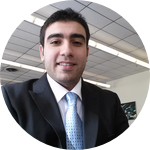 Bashar Hamza4
Bashar Hamza4 Joseph M Martel4
Joseph M Martel4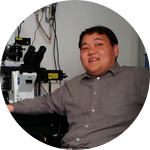 Albert Bae5
Albert Bae5
